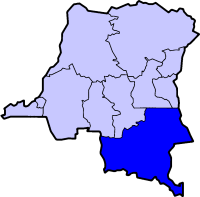
Front for the National Liberation of the Congo
Encyclopedia

Mobutu Sese Seko
Mobutu Sese Seko Nkuku Ngbendu wa Za Banga , commonly known as Mobutu or Mobutu Sese Seko , born Joseph-Désiré Mobutu, was the President of the Democratic Republic of the Congo from 1965 to 1997...
in Zaire
Zaire
The Republic of Zaire was the name of the present Democratic Republic of the Congo between 27 October 1971 and 17 May 1997. The name of Zaire derives from the , itself an adaptation of the Kongo word nzere or nzadi, or "the river that swallows all rivers".-Self-proclaimed Father of the Nation:In...
in the 1970s. The FNLC's invasions of Shaba
Shaba
Shaba may refer to:* Shaba, Kenya* Shaba National Reserve in Kenya* Shaba Province, name of Katanga Province in present DR Congo between 1971 and 1997* variant spelling of Shebaa`* Shaba Games...
, Zaire in 1977 and 1978 sparked two international wars, Shaba I
Shaba I
Shaba I was a conflict between the neighbouring states of Zaire and Angola in 1977, and was arguably a consequence of Zaire's support for the FNLA and UNITA factions in the Angolan Civil War....
and Shaba II
Shaba II
Shaba II was an invasion of the Shaba separatist movement FNLC into the Zairian province of Shaba on 11 May 1978. The FNLC had its bases in eastern Angola and probably had the support of the Angolan government...
, further complicating the Angolan Civil War
Angolan Civil War
The Angolan Civil War was a major civil conflict in the Southern African state of Angola, beginning in 1975 and continuing, with some interludes, until 2002. The war began immediately after Angola became independent from Portugal in November 1975. Prior to this, a decolonisation conflict had taken...
.
Shaba I
1,500 members of the FNLC, including a small group of former KatanganKatanga Province
Katanga Province is one of the provinces of the Democratic Republic of the Congo. Between 1971 and 1997, its official name was Shaba Province. Under the new constitution, the province was to be replaced by four smaller provinces by February 2009; this did not actually take place.Katanga's regional...
gendarmes
Gendarmerie
A gendarmerie or gendarmery is a military force charged with police duties among civilian populations. Members of such a force are typically called "gendarmes". The Shorter Oxford English Dictionary describes a gendarme as "a soldier who is employed on police duties" and a "gendarmery, -erie" as...
, invaded Shaba
Katanga Province
Katanga Province is one of the provinces of the Democratic Republic of the Congo. Between 1971 and 1997, its official name was Shaba Province. Under the new constitution, the province was to be replaced by four smaller provinces by February 2009; this did not actually take place.Katanga's regional...
, Zaire
Zaire
The Republic of Zaire was the name of the present Democratic Republic of the Congo between 27 October 1971 and 17 May 1997. The name of Zaire derives from the , itself an adaptation of the Kongo word nzere or nzadi, or "the river that swallows all rivers".-Self-proclaimed Father of the Nation:In...
from eastern Angola on March 7, 1977. The FNLC wanted to overthrow Mobutu. They quickly captured Kolwezi
Kolwezi
Kolwezi is a city in Katanga Province in the south of the Democratic Republic of the Congo, west of Likasi. It is home to an airport and a railway to Lubumbashi. The population is approximately 418,000....
, Zaire's economic heartland, Kasaji, and Mutshatsha
Mutshatsha
Mutshatsha is a town in central Democratic Republic of the Congo.- See also :* Railway stations in DRCongo* Transport in the Democratic Republic of the Congo- External links :* * *...
and defeated Zairian troops without difficulty. Mobutu appealed to William Eteki of Cameroon
Cameroon
Cameroon, officially the Republic of Cameroon , is a country in west Central Africa. It is bordered by Nigeria to the west; Chad to the northeast; the Central African Republic to the east; and Equatorial Guinea, Gabon, and the Republic of the Congo to the south. Cameroon's coastline lies on the...
, Chairman of the Organization of African Unity, for assistance on April 2. The French government airlifted 1,500 Moroccan troops into Kinshasa
Kinshasa
Kinshasa is the capital and largest city of the Democratic Republic of the Congo. The city is located on the Congo River....
on April 10. This troop force worked in conjunction with the Zairian army to beat back the FNLC with air cover from Egypt
Egypt
Egypt , officially the Arab Republic of Egypt, Arabic: , is a country mainly in North Africa, with the Sinai Peninsula forming a land bridge in Southwest Asia. Egypt is thus a transcontinental country, and a major power in Africa, the Mediterranean Basin, the Middle East and the Muslim world...
ian pilots flying French Mirage
Mirage (aircraft)
Mirage is the name of a series of delta-winged fighters and bombers that have been produced by the French aircraft manufacturer Dassault Aviation, flown by the French Air Force, and widely exported to foreign counties.* Dassault Mirage III...
fighter aircraft. The Franco-Egyptian-Moroccan force pushed the last of the militants, along with a number of refugees, into Angola and Zambia by April.

